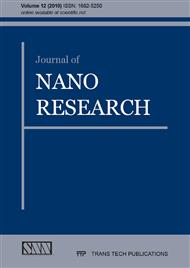p.1
p.45
p.55
p.65
p.77
p.89
p.99
p.105
p.115
Novel, Simple, Versatile and General Synthesis of Nanoparticles Made from Proteins, Nucleic Acids and other Materials
Abstract:
A new, simple, and versatile method was developed to prepare protein nanoparticles, for the first time, and the approach was extended to prepare organic, inorganic, and biological nanomaterials. For example, nanoparticles of met-hemoglobin and glucose oxidase are readily prepared by contacting a fine spray of aqueous solutions of the proteins to an organic solvent such as methanol or acetonitrile. The protein nanoparticles suspended in organic solvents retained their secondary structure and biological activities to a significant extent. Using this approach, we also successfully prepared nanoparticles of transition metal complexes, organic molecules, nucleic acids, inorganic polymers, and organic polymers. Particle size depended on reagent concentrations, pH and the solvent used, and particle sizes have been controlled from 20 to 200 nm by adjusting these parameters. In each case, particle sizes and size distributions were determined by dynamic light scattering and the data have been confirmed by electron microscopy. Addition of appropriate electrolytes to the nanoparticle supensions stabilized them against aggregation or crystallization, and particles were stable over months of storage at 4°C. Nanoparticles of met-hemoglobin, glucose oxidase, and calf thymus DNA indicated retention of their native-like structures, as evidenced from their respective circular dichroism spectra. Enzyme nanoparticles retained their catalytic activities to a significant extent. For example, peroxidase-like activity of met-hemoglobin nanoparticles suspended in methanol was 0.3 M-1 s-1, which is comparable to the activity of met-hmoglobin in aqueous buffer (1.0 M-1 s-1) even though the former has been measured in methanol. This activity is far greater than the activity of free heme in methanol. Thus, the nanobiocatalysts retained substantial activity in organic solvents. Nanoparticles of anthracene indicated extensive excitonic coupling due to inter-chromophore interactions. The current method of nanoparticle synthesis is rapid, simple, versatile, reproducible and resulted in the formation of nanoparticles from a variety of materials, many of them for the first time.
Info:
Periodical:
Pages:
77-88
Citation:
Online since:
December 2010
Keywords:
Price:
Сopyright:
© 2010 Trans Tech Publications Ltd. All Rights Reserved
Share:
Citation:


